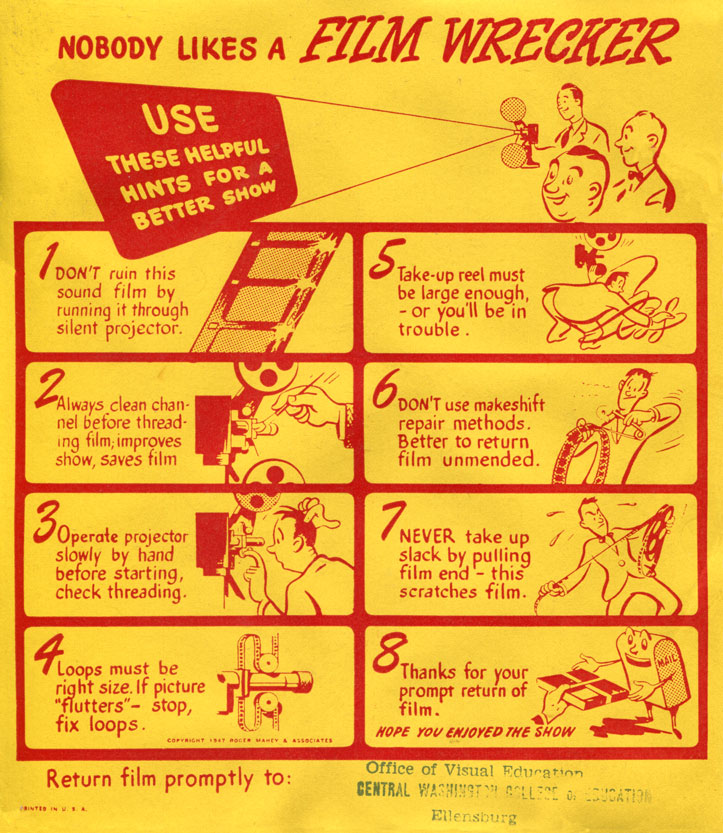

 |
 |
 |
 |
 |
 |
 |
 |
 |
 |
 |
 |

Film Preservation Basics
If you have some old films, they deserve the proper care to save
them for future generations.
Of course, most of the films we have were meant to be shown and
shared. A film sitting on a shelf doesn't serve its purpose.
Deterioration symptoms:
Wear
The most common kinds of wear are perforation damage, base
scratches. emulsion scratches and breaks. Perforation damage
is usually caused by either a malfunctioning projector, a
misthreaded projector, or a projector that has lost its
loop. Base scratches appear as black lines and are on the
side away from the emulsion. When duplicating a film, base
scratches can be minimized by wet gate printing. Emulsion
scratches are green or white lines scratched into the
emulsion. There is no cure for emulsion scratches.
Color Fading
The most common problem with long term storage of film is color
fading. With B&W film you only need to worry about base
degradation (vinegar syndrome). Some film stocks fade very
little, and others fade severely. Generally, cyan
(blue-green) goes first, followed by yellow, ultimately leaving
only magenta. Eastmancolor from the about 1953 through 1982 is the
worst, though it can be quite variable. See my film stock
identifier page (link). Heat is the main
accelerating factor. The quality of processing also affects it,
prints from some labs always fade severely, others hold up much
better under the same storage conditions.
Vinegar Syndrome
Vinegar Syndrome is a breakdown of the acetate base. When
deterioration occurs, acetic acid vapors are produced, creating a
distinctive vinegar aroma. The acid produced accelerates the
process. Keeping the film in a sealed can traps the vapors,
accelerating it further. Vinegar Syndrome causes the film to
warp, shrink and become brittle. High humidity and high
temperature speed the process. I suspect that residual
processing chemicals are a significant factor. Polyester
base film is immune to vinegar syndrome. The earlier
diacetate film (before the mid 1940s) might be slightly less prone
to vinegar syndrome, but often emits a camphor or "mothball" smell
due to the plasticizers used. Agfa-Gevaert stock emits a
peculiar odor, which should not be confused with vinegar syndrome.
Enemies of film:
Wear
Always keep the film path on your projector squeaky clean.
Naphtha, Filmrenew or alcohol on a cotton swab work well for this
purpose. When you acquire a projector, run a loop of blank
film through the projector several times to be sure that there are
no burrs that might scratch the film.
Heat
Heat is the main contributing factor to color fading, and
accelerates Vinegar Syndrome. Keep film as cool as
possible. Never store film in an attic. I try to keep
most of my films below 60 deg. F (15 C) as much as possible.
At the extreme, freezing film will preserve it almost
indefinitely, but care must be taken to prevent condensation on
the film.
Humidity
Humidity is the main contributing factor to Vinegar
Syndrome. Never store films (especially acetate) above 50%
RH. Air conditioning units help reduce humidity, and
stand-alone dehumidifiers are readily available. Extremely
low humidity isn't good either, storage below 20% RH can make the
film brittle.
Cleaning film:
Never clean film with water or a water based cleaner. It is
best to use a cleaner made for film. I usually use Filmrenew
which is a cleaner with lubricant and conditioner. It is
relatively cheap and can help warped or brittle film.
Naphtha can also be used, as can pure alcohol (99+%), avoid
rubbing alcohol as it contains water. All of these cleaners
must be used under adequate ventilation, as the fumes are
hazardous. Film cleaner can be applied with a clean soft
cloth such as an old T-shirt.
Film preservation resources:
The Home Film Preservation Guide, an excellent resource for the
novice in film preservation:
http://www.filmforever.org
Conservation On Line at Stanford University, a great list of
articles on film preservation:
http://palimpsest.stanford.edu/bytopic/motion-pictures/
Image Permanence Institute at the Rochester Institute of
Technology:
http://www.imagepermanenceinstitute.org/index.html
National film Preservation Foundation:
https://www.filmpreservation.org/
Home Movie Day, dedicated to the preservation of home movies on
film:
http://www.homemovieday.com/
Video transfer resources at Home Movie Day:
https://www.centerforhomemovies.org/transfer-houses/
Urbanski Film, source of film cleaner, editing supplies and
Molecular Sieves in smaller quantities (Larry specializes in
providing supplies to the amateur as well as to professionals):
http://www.urbanskifilm.com
Eastman Kodak's recommendations for film storage:
https://www.kodak.com/en/motion/page/handling-of-processed-film/

Please contact me if you have
any suggestions for improvements to this page.
Updated 9-5-24 to fix broken links.
Copyright 2004-2024, Paul Ivester. Please do not copy
without permission.